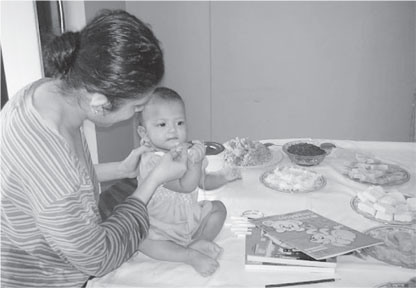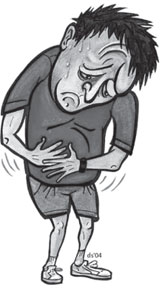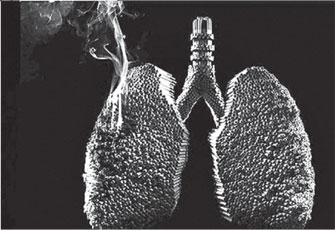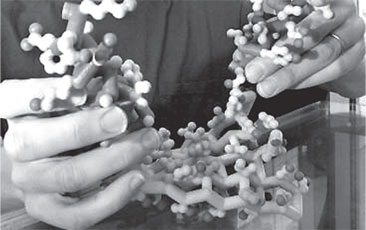|

Complementary feeding to combat malnutrition
By Nilma Dole
We often think that the rise in cost of living contributes to the
malnutrition problem.
While it could be true for some, research has proven that it is the
complementary feeding habits of mothers, midwives, relatives and even
what the astrologer says that have a considerable influence in the way
we feed our children.
 Auspicious observances are not negative but it has been shown that
this has indirectly contributed to the malnutrition problem which
happens at a young age and affects when they are adults. Auspicious observances are not negative but it has been shown that
this has indirectly contributed to the malnutrition problem which
happens at a young age and affects when they are adults.
Breastfeeding should continue when the child is two years of age, but
complementary feeding also should be done hand-in-hand after the child
is six months.
Food culture
“In Sri Lanka, we have what is called a food culture. We have
reported success in breast-feeding exclusively but we should introduce
good complementary feeding immediately after six months,” said
Consultant Physician at the Family Health Bureau Dr. Hiranya
Jayawickrama at a seminar at the Health Education Bureau.
The childhood effects of malnutrition especially during the growing
stages makes an impact on the child when they grow as adults.
“There is an increased risk of illness and death, lower performance
in studies, shorter adult height, reduced adult height, high risk of
non-communicable diseases (NCDs) and low birth weight babies born to
women with malnutrition if the child doesn't have proper nutrition at a
young age,” she said.
There are policies and strategies in place to tackle malnutrition but
also it is the duty of mothers, families, midwives and doctors to help
in ensuring that they are followed.
Improper practices in complementary feeding contribute to the
malnutrition problem. The right methods of feeding your child should be
adopted.
Dr. Jayawickrama said, “When complementary feeding starts, make sure
that the quantity of food is adequate, don't feed the child food
alternatives or meal replacements such as sweets and biscuits which
don't contain much nutrition. Even though your child doesn't eat, make
sure you don't distract the child to eat something by making them get
used to unhealthy sweet and salty foods because it contributes to
obesity and juvenile diabetic problems at an early age.” If poor quality
foods such as watery soup without any soft semi-solids is given, it
isn't nutritious.
Flavours
“Prepare food hygienically, gradually add a range of new foods so
that a child can get used to the different types of food flavours,” she
said. The right amount of food should be given to the child where at six
to eight months, mothers should start feeding the child with two to
three teaspoonfuls per feed gradually increasing to about 100 ml of
thick soup. At nine to 11 months, about a 150 ml and at 12 to 13 months,
200 ml of thick soup should be given.
It is important to give the child healthy food during illness as a
majority of mothers reduce the level of nutrition with watery soups and
just liquids but this shouldn't be done. She said, “More food and
healthy liquids such as juices should be given to the child during
illness and immediately after they recover, because this will strengthen
their immune system and proper nutrition will help in the recovery
process.”
|
Feeding tips |
* Feed infants directly. Assist older children when they feed
themselves.
* Feed older children during family meal times
* Learn to recognise a child's hunger and satiety cues
* Avoid force-feeding
* Keep a fixed place for feeding
* Keep regular times of feeding
* Minimise distractions during feeding
* Talk lovingly to your child during feeding while maintaining
eye-to-eye contact
* Praise the child for eating well
* Try different methods of encouragement
* Experiment with different food combinations and see what the child
likes
* Encourage the child to drink and eat with lots of patience
* Feed small amounts frequently
* Offer nutritious food that the child likes
* Offer a variety of nutrient-rich foods
* Add oil, thick coconut milk, butter and other essential fatty acids as
usual
* Continue to breast-feed
Courtesy Family Health Bureau, Sri Lanka Ministry of Health
|
She said that a child of seven to eight months needs two or three
main meals a day with one or two healthy snacks in between and a child
of nine to 24 months needs three to four main meals a day with one or
two meals in between.
There also needs to be consistency in the food with well-mashed and
boiled food given at six months to fine particles which won't make the
child choke. After the age of one, finger foods and soft semi-solids
with partly solid food should be given with close supervision.
Giving his comments about child nutrition was renowned paediatrician
Prof. Harendra de Silva, who said, “The problem is giving the child thin
gruel. You should give your child thick soup and congee which is good
for growth.” According to the paediatrician, mothers should introduce
complementary foods in a form thick enough to stay in the spoon which is
easy for the child to eat and not hard-solid food but in a semi-solid
form.
The doctor said, “I have seen that leftover rice-water washed from
the rice that is used to give household members is given to the child
which contains absolutely no nutrition. I think that the water washed
after eating rice has more nutrition because it carries the oils from
curries but that isn't what we should give the child.”
Prof. de Silva said that introducing essential fatty acids and oils
is important to help giving the right nutrition to your child. He said,
“Introducing butter and oils such as coconut oil will give your child
good nutrition in the form of high calories and high energy density
food. This won't make your child obese but will promote good nutrition.
The doctor said, “What is given for the child to eat at a young age
impacts not only nutrition and health at a young age but also their food
habits when they are adults.”
Food with a high energy density will help nurture your child but also
eating the right food such as carbohydrates, rice, pulses such as
lentils (parippu), fresh vegetables and fruits, seeds such as jak seeds
and a variety of mashed nuts in the food will contribute to good
nutrition.”
Judgements
Another point that he raised was that parents think they are always
correct when it comes to knowing what is right for the child and make
judgements based on the child's behaviour. The doctor said, “I have come
across parents who speak for their child because how can a child talk
about what is wrong and right?”
He said that during complementary feeding, if the child stops
breast-feeding on their own, the mother thinks that they prefer eating
food instead of wanting their milk.
“This is a misconception but it happens because the mother gives the
child a tit or a bottle which resembles a nipple which confuses the
child that that is their milk instead of cow's milk,” he said.
The doctor said that responsive feeding was important to get the
child to eat food, taste a variety and see what they like and the
ability to eat without being force-fed.
“When getting a child to eat, the secret is to encourage the child to
eat with the family, sitting on the feeding chair and get them to eat
with you and get the child involved. Don't feed the child separately or
distract the child because it won't make them concentrate on eating
their food,” he said.
The paediatrician also raised the auspicious observances pertaining
to eating the first meal.
He said, “The Indul Kata Gama ceremony has made an impact on the
statistics of malnutrition being more prevalent among boys than girls.
Going by the Indul Kata Gama ceremony, girls eat earlier than boys.”
Auspicious times
According to astrologers, for boys, an auspicious time during six,
eight and 10 (even number) months of age from the birth for boys is
considered best for the ceremony and five, seven, nine, 11 months from
the birth for girls are considered the best.
However, according to Prof. de Silva if you want the best for your
child, you should introduce food at six months no matter what gender.
UNICEF's Sri Lanka representative, Dr. Reza Hossaini said, “In a
country of abundance and aplenty it is difficult to imagine that Sri
Lanka has a malnutrition problem. “However, you need to tackle this
problem at a grassroot level with educating families to check the
nutrition levels of their babies, toddlers and children so that doctors
can advise them accordingly,” he said.
Moreover, the UNICEF country representative said that if Sri Lanka
can combat malnutrition it is possible that Sri Lanka can become a
developed nation. He said, “Sri Lanka's leaders want to develop the
country from a low middle-income country to a high middle-income
country, but you need healthy citizens to ensure that productivity is
kept to an optimum.”
A donation of anthropometric equipment to measure nutrition levels in
children courtesy UNICEF and the Family Health Bureau was given to the
Ministry of Health's Director General, Plantation Human Development
Trust as malnutrition was a big problem in the plantation sector.
Food poisoning: Delay in identifying source fatal
As illustrated by the 2011 E. coli outbreak in Germany in 2011, any
delay in identifying the source of food poisoning outbreaks can cost
lives and cause considerable political and economical damage.
An international multidisciplinary team of scientists have shown that
difficulties in finding the sources of contamination behind food
poisoning cases are inevitable due to the increasing complexity of a
global food traffic network where food products are constantly crossing
country borders, generating a worldwide network.
 As consumers we are used to seeing country of origin labels on
certain foods, but what about on products with more than one ingredient?
A recent study by the Food Safety Authority of Ireland showed that 53
countries contributed to the ingredients of an ordinary “Chicken Kiev”
in a Dublin restaurant. As consumers we are used to seeing country of origin labels on
certain foods, but what about on products with more than one ingredient?
A recent study by the Food Safety Authority of Ireland showed that 53
countries contributed to the ingredients of an ordinary “Chicken Kiev”
in a Dublin restaurant.
This diversity of sources is partly to blame for the failure to
identify the sources of food poisoning outbreaks, and has lead to calls
for international health agencies to initiate a system to monitor this
‘human food web.’ But just how complex is the human food web? What is
its structure, can we quantify it, and what can we learn from it?
Network
In the first study of its kind, published in the journal PLoS ONE,
the scientists studied databases of food import and export to understand
how ‘food fluxes’ generate a complicated worldwide network.
They were led by Professor József Baranyi of the Institute of Food
Research, which is strategically funded by the Biotechnology and
Biological Sciences Research Council.
Using agri-food import-export data from the UN and FAO databases, the
authors chart out the worldwide food-transport network and show that it
forms an amazingly complex transport web.
With the help of network science methods they reveal that it has
highly vulnerable hotspots and demonstrate that, without increased
control, some of these are prime positions for making outbreak tracing
difficult.
The research identifies a number of countries as being central to the
network or holding particular influence due to the dynamics of the food
traffic, and stricter regulation in monitoring food trade here could
benefit the network globally. Countries that take in many ingredients,
process these into products, and act as distribution hubs are of
particular concern.
Melting pot
“We found that the current structure of international food trade
effectively makes The Netherlands a combined melting pot and Lazy Susan,
with the busiest link to Germany,” said Professor Baranyi.
“This could explain why the tracing of the source suffered long
delays in these countries in two serious outbreaks in 2011.
This could be observed in both the E. coli outbreak in sprouts and
the dioxin contamination in eggs.”
The findings are supported by two types of analyses: one is based on
the graph theoretical analysis of the structure of the international
food trade network that allows the identification of the network core
using the well-established “betweenness centrality” measures of nodes
and edges for this purpose; the other is a measure based on the dynamics
of the food-flow on the network, expressing to what extent a country is
a “source” or a “sink”.
This work also introduces and validates for the first time a
rigorous, quantitative methodology to help with biotracing and
identifying the sources of food poisoning outbreaks, a problem that is
only expected to increase in its magnitude, complexity and impact, in
the face of current globalisation trends.
-MNT
New interactive smoking cessation website designed
Stop Advisor is a new web-based smoking cessation program, which
takes smokers from preparation for the target quit date to the quit date
itself.
It achieves this by offering expert advice through a combination of
interactive menus and personalised sessions.
 Post quit date, it encourages users to report important information
that the program will use to help them overcome the difficulties they
encounter along the way. In their study, Robert West and Susan Michie
from University College London and collaborators describe the
development process of the StopAdvisor intervention. Post quit date, it encourages users to report important information
that the program will use to help them overcome the difficulties they
encounter along the way. In their study, Robert West and Susan Michie
from University College London and collaborators describe the
development process of the StopAdvisor intervention.
Need
Their work appears online in Translational Behavioral Medicine:
Practice, Policy, Research, published by Springer.
Since smoking remains the largest single preventable cause of
premature death and illness worldwide, there is a pressing need to find
better ways to help smokers to quit.
The internet has huge potential and is extremely cost-effective, i.e.
low cost per user.
StopAdvisor is the result of the analysis and synthesis of 19
theoretical principles, 33 evidence- or theory-based behavior change
techniques, 26 web-design principles and 9 principles from user-testing.
It is designed to be attractive and effective across social groups.
To make StopAdvisor relevant to all social groups, user-testing was
conducted among less educated smokers in lower paid jobs, a group
notoriously difficult to reach and engage.
Unique
What is unique about the research team's approach is the use of an
open-source web-development platform (LifeGuide), which allowed the
researchers to test individual elements of their intervention and adjust
them as they went along, based on user and researcher feedback
throughout the development phase.
The authors said, “To our knowledge, this is the first attempt to be
fully transparent about the content and development of a
population-reach behaviour change intervention.”
The paper describes the development process of the StopAdvisor
intervention and provides a full description of how the intervention
works.
Its effectiveness is currently being evaluated in a randomised
controlled trial (the highest level of evidence for a scientific study).
The authors have made a commitment to continue incrementally
developing and building the technology as a community of researchers.
- topix
Neural rhythms found to drive physical movement
A new model for understanding how nerve cells in the brain control
movement may help unlock the secrets of the motor cortex, a critical
region that has long resisted scientists’ efforts to understand it,
researchers report in Nature.
Scientists at Washington University in St. Louis, Stanford University
and Columbia University have shown that the motor cortex's effects on
movement can be much more easily understood by looking at groups of
motor cortex neurons instead of individual nerve cells.
In the study, scientists identified rhythmic brain cell firing
patterns coordinated across populations of neurons in the motor cortex.
 They linked those patterns to different kinds of shoulder muscle
movements. They linked those patterns to different kinds of shoulder muscle
movements.
Neurons
“Populations of neurons in the motor cortex oscillate in beautiful,
coordinated ways,” says co-first author John Cunningham, assistant
professor of biomedical engineering at Washington University in St.
Louis.
“These patterns advance our understanding of the brain's control of
movement, which is critical for understanding disorders that affect
movement and for creating therapies that can restore movement.”
Until now, scientists had based their studies of the motor cortex on
decades-old insights into the workings of the visual cortex.
In this region, orientation, brightness and other characteristics of
objects in the visual field are encoded by individual nerve cells.
However, researchers could not detect a similar direct encoding of
components of movement in individual nerve cells of the motor cortex.
“We just couldn't look at an arm movement and use that to reliably
predict what individual neurons in the motor cortex had been doing to
produce that movement,” Cunningham says.
For the new study, conducted at Stanford University, scientists
monitored motor cortex activity as primates reached for a target in
different ways. They showed that the motor cortex generated patterns of
rhythmic nerve cell impulses.
“Finding these brain rhythms surprised us a bit, as the reaches
themselves were not rhythmic,” says co-first author Mark Churchland, who
was a postdoctoral researcher at Stanford at the time of the study and
is now assistant professor of neuroscience at Columbia University. “In
fact, they were decidedly arrhythmic, and yet underlying it all were
these unmistakable patterns.”
Cunningham compares the resulting picture of motor cortex function to
an automobile engine. The engine's parts are difficult to understand in
isolation but work toward a common goal, the generation of motion.
Spark plug
“If you saw a piston or a spark plug by itself, would you be able to
explain how it makes a car move?” Cunningham asks. “Motor-cortex neurons
are like that, too - they are understandable only in the context of the
whole.”
Researchers are applying their new approach to understanding other
puzzling aspects of motor cortex function.
“With this model, the seemingly complex system that is the motor
cortex can now be at least partially understood in more straightforward
terms,” says senior author Krishna Shenoy, PhD, associate professor of
electrical engineering at Stanford.
-bioportfolio
|

